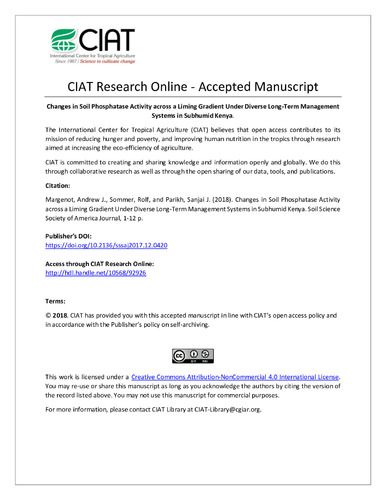Soil Phosphatase Activities across a Liming Gradient under Long-Term Managements in Kenya
Core Ideas We investigated liming in soil mesocosms from 11‐yr managements: no input, mineral N+P, and manure. There were minor or no changes in labile inorganic P, labile organic P, and microbial biomass P. Changes in the activity of different phosphatases following liming depended on management. Liming decreased acid phosphomonoesterase/phosphodiesterase across management systems. Liming can impact the enzymatic component of soil P cycling in the short term.We investigated liming in soil mesocosms from 11‐yr managements: no input, mineral N+P, and manure.There were minor or no changes in labile inorganic P, labile organic P, and microbial biomass P.Changes in the activity of different phosphatases following liming depended on management.Liming decreased acid phosphomonoesterase/phosphodiesterase across management systems.Liming can impact the enzymatic component of soil P cycling in the short term.Changes in the biological drivers of soil P cycling could contribute to improving P availability in weathered soils after liming. The effect of liming on P cycling was evaluated for a Rhodic Kandiudox in western Kenya under no fertilization (UNF), mineral N + P (MIN), and manure (ORG). Ca(OH)2 was applied at six rates in soil mesocosms to establish a pH gradient (4.7–6.4). Labile inorganic P (Pi) increased by ≤1.2 μg g–1 in response to lime and labile organic P (Po) was weakly affected. In MIN, microbial biomass P (Pmic) decreased at ≥6.0 Mg ha–1 (–24%). Liming changed phosphatase activity depending on the management and phosphatase type but did not reflect commonly proposed pH optima of phosphatases. In UNF and MIN, acid phosphomonoesterase activity decreased with pH, and alkaline phosphomonoesterase and phosphodiesterase activity showed minor changes. Liming under ORG altered activity by up to +16% for acid phosphomonoesterase, –16% for alkaline phosphomonoesterase, and +36% for phosphodiesterase. Similar trends were observed for Pmic–normalized activity, including decreased acid phosphomonoesterase under UNF and increased phosphodiesterase under ORG. Pmic–normalized acid phosphomonoesterase activity under ORG was unaffected by liming whereas Pmic–normalized phosphodiesterase activity exhibited a marked decrease under UNF. Across managements, the acid phosphomonoesterase/phosphodiesterase activity ratio peaked at pH 5.0 and decreased thereafter. Despite management‐induced differences in soil P availability, consistent changes in phosphatase activity ratios indicate a short‐term impact of lime on the enzymatic component of P cycling, which could translate to longer‐term changes in Po mineralization and available P.

